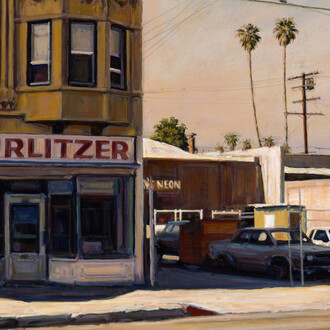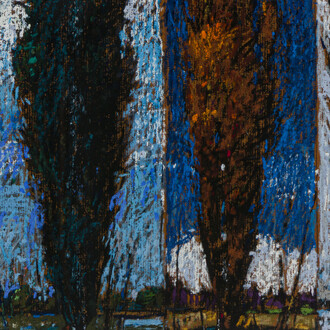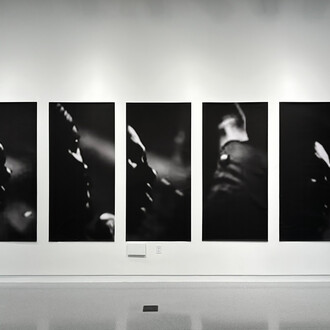While recovering from a brush with breast cancer a couple of years ago, Naomie Kremer sought to observe herself from an external perspective by creating a nude video portrait with her iPhone camera. Kremer had worked extensively in video for over a decade, but the self-discovery she experienced while viewing her own unclothed body inspired a new direction in her work, which will be a focal point in her 16th solo show at Modernism next month.
Embodiment is an immersive environment that explores issues of embodiment, the individual, and interpersonal relationships,” Kremer explains. To create the six- channel video and sound installation, she asked friends and acquaintances to undress and follow her simple directions while she filmed them. The subjects of her video portraits range in age from two to ninety. In some cases, she filmed couples or families with children, capturing both individual movement and interactions. “None of the subjects is accustomed to being nude in public,” she says. “Nudity involves stripping off the most basic way of presenting oneself in the world. Unclothed, the body can only present itself, serving as a canvas for overlays of story.
The overlays in Kremer’s video portraits incorporate her many years of work in video as well as the abstract paintings that are another major dimension of her artistic practice. She uses this imagery as “found material” to accentuate aspects of her subjects’ personalities while also partially masking their identities. Meticulously edited to cloak subjects’ bodies in layers of metaphor, these richly nuanced “skins” connect Embodiment with the other artwork in her Modernism exhibition.
Some of these paintings are abstract landscapes, keenly observed, monumental in scale, and rendered with brushwork that is equal parts Monet and De Kooning. Her marks are dense and interconnected, which is congruent with her idea that everything is related, including the landscape and the body. “I paint the landscape as a body and the body as a landscape,” she says.
Some of these paintings, such as Camouflage (2020), are derived directly from video portraits, treating the video itself as her subject. Others, such as Then and Now: French Connection (2006), reveal the longstanding interest in figuration that has informed her recent video work. Then and Now includes imagery of a man and woman, as well as gardens and French windows, all of which come in and out of focus, holding the viewer’s attention through her deft combination of specificity and ambiguity. “Abstraction is part of everything I do,” she explains. “I’m looking to make the real more real by making it strange.”
Kremer also has a history of achieving this heightened state of awareness using painting and video in combination. Her “hybrid” paintings are created by projecting video she creates specifically for each painting directly onto the surface of a painted canvas, engaging the viewer with constant changes in pattern. “Much as the hybrid paintings play with visual perception, the nude portraiture series works on the emotional aspects of perception,” Kremer observes. The viewer engages with her subjects through the complex interplay of their guileless gestures and the elaborate environments she invents for them.
As a video artist, Kremer combines the cinematic virtuosity of Bill Viola with the psychological acumen of Lynn Hershman Leeson. However, she also sees her work in terms of the present political moment. “Stripped, unclothed, naked, and nude are words both literal and metaphoric,” she says. “In our truth-challenged moment, variations on varnishes flourish, but these adjectives are powerful reminders of veracity. Nudity brings us closer not only to nature, but also to our own nature.”
With its penetrating honesty, Kremer’s art challenges us to undergo a process of self-discovery.
Naomie Kremer’s work has been exhibited widely in the U.S. and abroad. Her video-based set designs include the opera Alcina, by Handel, performed at the Crusader Fortress in Acre, Israel, The Secret Garden commissioned by the San Francisco Opera, and Light Moves, a collaboration with Margaret Jenkins Dance Company. Her exhibition The Age of Entanglement at the San Jose Institute of Contemporary Art in 2015 was selected as one of the year’s best by the publication Square Cylinder. Rudimentary Moves, a video piece by Kremer, was exhibited at the Berkeley Art Museum on their large-scale outdoor LED screen during the opening month of the new museum in February 2016. Kremer also has an ongoing nightly video installation at SF Jazz Center.
Her work is in many collections, including the Berkeley Art Museum; The Whitney Museum; the Fine Arts Museums of San Francisco; the Magnes Museum, the United States Embassy in Beijing, China, and most recently the Arkansas Arts Center.
Kremer has taught painting and drawing at The San Francisco Art Institute, California College of the Arts, California State University at Hayward, and the Pont-Aven School of Contemporary Art in Brittany, France. She has lectured at the Ruskin School of Art at Oxford University, England, and at the Syracuse University program in Florence, Italy, among others.
Naomie Kremer works in Berkeley, California, New York City, and Paris, France.
















